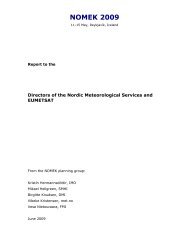International Symposium on Mitigative Measures against Snow ...
International Symposium on Mitigative Measures against Snow ...
International Symposium on Mitigative Measures against Snow ...
You also want an ePaper? Increase the reach of your titles
YUMPU automatically turns print PDFs into web optimized ePapers that Google loves.
<str<strong>on</strong>g>Internati<strong>on</strong>al</str<strong>on</strong>g> <str<strong>on</strong>g>Symposium</str<strong>on</strong>g> <strong>on</strong> <strong>Mitigative</strong> <strong>Measures</strong> <strong>against</strong> <strong>Snow</strong> Avalanches<br />
Egilsstaðir, Iceland, March 11–14, 2008<br />
was asked to provide rescuers from the Reykjavík area to go with a coast guard vessel to the<br />
area. Transportati<strong>on</strong> by air was impossible because of the weather. The coast guard vessel left<br />
Reykjavík at 14:40 hours with rescuers and medical staff (Bernharðsdóttir, 2001). So<strong>on</strong> after<br />
that, the trawler Engey left Reykjavik with additi<strong>on</strong>al rescuers. At the same time, ships and<br />
boats from various towns and municipalities closer to the area, were sent to Súðavík. In all<br />
300 rescue team members were in acti<strong>on</strong> during the operati<strong>on</strong>.<br />
The first wave of rescuers coming to Súðavík arrived at 09:42 hours in the morning, more<br />
than three hours after the avalanche struck. With them were trained avalanche dogs, command<br />
and medical staff. A collecti<strong>on</strong> point for rescuers was set up in the local freezing plant and<br />
rescuers were sent to search at likely locati<strong>on</strong>s; the dogs worked very well and marked likely<br />
positi<strong>on</strong>s and the rescuers started to dig at these locati<strong>on</strong>s. All rescuers that went from the<br />
collecti<strong>on</strong> point had to carry avalanche beac<strong>on</strong>s for safety. More rescuers arrived from<br />
Ísafjörður and towns around the area. The coast guard vessel arrived with rescuers from the<br />
Reykjavík area at 14:20 hours <strong>on</strong> 17 th of January. At that time the local rescuers and<br />
volunteers from the area had been working for 36 hours. Only two of those originally buried<br />
by the avalanche were still missing. At 18:00 hours <strong>on</strong> 17 th of January all missing pers<strong>on</strong>s had<br />
been found.<br />
The work of the rescuers in the field became more and more difficult as time passed during<br />
the operati<strong>on</strong>. This is comm<strong>on</strong> in urban search and rescue. First you rescue those who are easy<br />
to access and after that you dig deeper and deeper into the rubble. A number of huge rafters<br />
had to be cut and the rescuers used chain shaws, crowbars and other manual tools. <strong>Snow</strong><br />
shovels were the main tool to gain access to the houses needed to be searched. The local<br />
incident commander used an old town map to mark in the avalanche and likeliest spots<br />
survivors could be found. Other indicators that the searchers used were blood trails that were<br />
found in the snow (Avalanche 95).<br />
When rescue operati<strong>on</strong>s finished, it took until Thursday 19 th of January to get every rescuer<br />
back to his home because of adverse weather. In the following week, rescuers from all over<br />
country were sent <strong>on</strong> rotati<strong>on</strong> to help the local rescue teams to collect bel<strong>on</strong>gings of those<br />
caught up in the avalanche. But the horror was not over. On 26 th of October the same year,<br />
another avalanche struck.<br />
Thorkelss<strong>on</strong> 103











